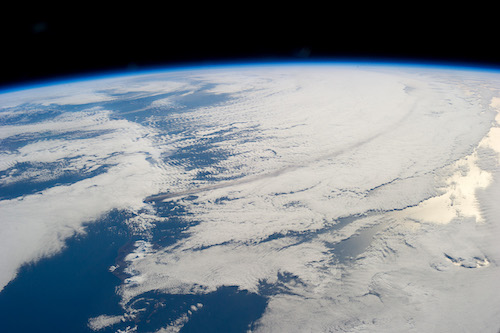.
What caused the largest glaciation event in Earth’s history, known as ‘snowball Earth’?
Geologists and climate scientists have been searching for the answer for years but the root cause of the phenomenon remains elusive.
Now, Harvard University researchers have a new hypothesis about what caused the runaway glaciation that covered the Earth pole-to-pole in ice.
The research is published in Geophysical Research Letters.
Researchers have pinpointed the start of what’s known as the Sturtian snowball Earth event to about 717 million years ago — give or take a few 100,000 years. At around that time, a huge volcanic event devastated an area from present day Alaska to Greenland.
Coincidence?
Harvard professors Francis Macdonald and Robin Wordsworth thought not.
“We know that volcanic activity can have a major effect on the environment, so the big question was, how are these two events related,” said Macdonald, the John L. Loeb Associate Professor of the Natural Sciences.
At first, Macdonald’s team thought basaltic rock — which breaks down into magnesium and calcium — interacted with CO2 in the atmosphere and caused cooling. However, if that were the case, cooling would have happened over millions of years and radio-isotopic dating from volcanic rocks in Arctic Canada suggest a far more precise coincidence with cooling.
Macdonald turned to Wordsworth, who models climates of non-Earth planets, and asked: could aerosols emitted from these volcanos have rapidly cooled Earth?
The answer: yes, under the right conditions.
“It is not unique to have large volcanic provinces erupting,” said Wordsworth, assistant professor of Environmental Science and Engineering at the Harvard John A. Paulson School of Engineering and Applied Science. “These types of eruptions have happened over and over again throughout geological time but they’re not always associated with cooling events. So, the question is, what made this event different?”

A trail of smoke can be seen from the 2013 eruption of the Pavlof volcano, which spewed an ash cloud 20,000 feet into the atmosphere that traveled southeastward over the North Pacific Ocean. The volcanos that may have contributed to snowball Earth spanned almost 2000 miles and erupted continuously for years. (Image courtesy of NASA)
Geological and chemical studies of this region, known as the Franklin large igneous province, showed that volcanic rocks erupted through sulfur-rich sediments, which would have been pushed into the atmosphere during eruption as sulfur dioxide. When sulfur dioxide gets into the upper layers of the atmosphere, it’s very good at blocking solar radiation. The 1991 eruption of Mount Pinatubo in the Philippines, which shot about 10 million metric tons of sulfur into the air, reduced global temperatures about 1 degree Fahrenheit for a year.
Sulfur dioxide is most effective at blocking solar radiation if it gets past the tropopause, the boundary separating the troposphere and stratosphere. If it reaches this height, it’s less likely to be brought back down to earth in precipitation or mixed with other particles, extending its presence in the atmosphere from about a week to about a year.
The height of the tropopause barrier all depends on the background climate of the planet — the cooler the planet, the lower the tropopause.
“In periods of Earth’s history when it was very warm, volcanic cooling would not have been very important because the Earth would have been shielded by this warm, high tropopause,” said Wordsworth. “In cooler conditions, Earth becomes uniquely vulnerable to having these kinds of volcanic perturbations to climate.”
“What our models have shown is that context and background really matters,” said Macdonald.
Another important aspect is where the sulfur dioxide plumes reach the stratosphere. Due to continental drift, 717 million years ago, the Franklin large igneous province where these eruptions took place was situated near the equator, the entry point for most of the solar radiation that keeps the Earth warm.
So, an effective light-reflecting gas entered the atmosphere at just the right location and height to cause cooling. But another element was needed to form the perfect storm scenario. After all, the Pinatubo eruption had similar qualities but its cooling effect only lasted about a year.
The eruptions throwing sulfur into the air 717 million years ago weren’t one-off explosions of single volcanoes like Pinatubo. The volcanoes in question spanned almost 2,000 miles across Canada and Greenland. Instead of singularly explosive eruptions, these volcanoes can erupt more continuously like those in Hawaii and Iceland today. The researchers demonstrated that a decade or so of continual eruptions from this type of volcanoes could have poured enough aerosols into the atmosphere to rapidly destabilize the climate.
“Cooling from aerosols doesn’t have to freeze the whole planet; it just has to drive the ice to a critical latitude. Then the ice does the rest,” said Macdonald.
Cooling from aerosols doesn’t have to freeze the whole planet; it just has to drive the ice to a critical latitude. Then the ice does the rest.Tweet This
The more ice, the more sunlight is reflected and the cooler the planet becomes. Once the ice reaches latitudes around present-day California, the positive feedback loop takes over and the runaway snowball effect is pretty much unstoppable.
“It’s easy to think of climate as this immense system that is very difficult to change and in many ways that’s true. But there have been very dramatic changes in the past and there’s every possibility that as sudden of a change could happen in the future as well,” said Wordsworth.
Understanding how these dramatic changes occur could help researchers better understand how extinctions occurred, how proposed geoengineering approaches may impact climate and how climates change on other planets.
“This research shows that we need to get away from a simple paradigm of exoplanets, just thinking about stable equilibrium conditions and habitable zones,” said Wordsworth. “We know that Earth is a dynamic and active place that has had sharp transitions. There is every reason to believe that rapid climate transitions of this type are the norm on planets, rather than the exception.”
Quelle: HARVARD UNIVERSITY
